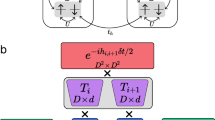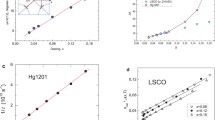Abstract
The Eliashberg theory, which is generalized due to peculiar properties of the finite-width electron band for electron–phonon (EP) systems with a variable electron density of states (DOS), as well as with allowance for the electron–hole nonequivalence of the frequency behavior of the chemical potential renormalization depending on the doping level and electron correlations in the vertex function, is used to study T c in cuprates. The phonon contribution to the nodal anomalous electron Green’s function (GF) is considered. Pairing within the total width of the electron band, and not only in a narrow layer at the Fermi surface, is taken into account. The calculated frequency and temperature dependences, as well as the dependence on the doping level of the complex renormalization ReZ, ImZ of the mass, complex renormalization Reχ(ω), Imχ(ω) of the chemical potential, and DOS N(ε) renormalized due to the EP interaction are used to calculate the electron nodal anomalous GF. It is found that the effect of suppressing the high-frequency contribution to the Eliashberg equations derived anew for the EP system with a finite width of the electron band is a decisive factor for the manifestation of the effect of high-temperature superconductivity (HTSC). It is shown that in the vicinity of the optimal hole-type doping level in cuprates, the high value of T c is reproduced by the spectral function of the electron–phonon interaction, which is obtained from tunneling experiments. Upon an increase in the doping level, leading to an increase in the degree of electron–hole nonequivalence, the new logarithmic term appearing in the equations for T c has a tendency to increase T c , while intensification of damping of charge carriers (especially suppression of the cutoff factor) leads to a decrease in T c .
Similar content being viewed by others
References
E. G. Maximov, M. L. Kulich, and O. V. Dolgov, condmat/10014859.
X. J. Zhou, T. Cuk, T. Devereaux, and N. Nagaosa, in Handbook of High-Temperature Superconductivity: Theory and Experiment, Ed. by J. R. Schrieffer (SpringerVerlag, Berlin, 2007), p. 87.
F. Marsiglio and J. P. Carbotte, in Superconductivity: Conventional and Unconventional Superconductors, Ed. by K. H. Bennemann and J. B. Ketterson (SpringerVerlag, Berlin, 2008), Vol. 1, p. 73.
A. S. Mishchenko, Phys.—Usp. 52 (12), 1193 (2009).
O. Gunnarson and O. Rosch, J. Phys.: Condens. Matter. 20, 043201 (2008).
V. Z. Kresin and S. A. Wolf, Rev. Mod. Phys. 81, 481 (2009).
G. M. Eliashberg, Sov. Phys. JETP 11, 696 (1960).
P. B. Allen and R. C. Dynes, Phys. Rev. B: Solid State 12, 905 (1975).
A. S. Aleksandrov and E. A. Mazur, Sov. Phys. JETP 69 (5), 1001 (1989).
A. Lanzara, P. V. Bogdanov, X. J. Zhou, S. A. Kellar, D. L. Feng, E. D. Lu, T. Yoshida, H. Eisaki, A. Fujimori, K. Kishio, J.-I. Shimoyama, T. Noda, S. Uchida, Z. Hussain and Z.-X. Shen, Nature (London) 412, 510 (2001).
Bok Jin Mo, Yun Jae Hyun, Choi Han-Yong, Zhang Wentao, Zhou X. J., and Chandra Varma M., Phys. Rev. B: Condens. Matter 81, 174516 (2010); Bok Jin Mo, Yun Jae Hyun, Choi Han-Yong, Zhang Wentao, X. J. Zhou, and Varma M. Chandra, condmat/09120088.
G.-H. Gweon, T. Sasagawa, and H. Takagi, Phys. Rev. Lett. 97, 227001 (2006); G.-H. Gweon, T. Sasagawa, and H. Takagi, cond-mat/07081027.
H. Iwasawa, J. F. Douglas, K. Sato, T. Masui, Y. Yoshida, Z. Sun, H. Eisaki, H. Bando, A. Ino, M. Arita, K. Shimada, H. Namatame, M. Taniguchi, S. Tajima, S. Uchida, et al., Phys. Rev. Lett. 101, 157005 (2008).
E. A. Mazur, Europhys. Lett. 90, 47005 (2010)
E. A. Mazur, Europhys. Lett. 90, 69901 (2010).
A. S. Aleksandrov, V. N. Grebenev, and E. A. Mazur, JETP Lett. 45 (7), 455 (1987).
S. Engelsberg and J. R. Schrieffer, Phys. Rev. 131, 993 (1963).
D. J. Scalapino, J. R. Schrieffer, and J. W. Wilkins, Phys. Rev. 148, 263 (1966).
W. L. McMillan, Phys. Rev. 167, 331 (1968).
A. E. Karakozov, E. G. Maksimov, and S. A. Mashkov, Sov. Phys. JETP 41 (5), 971 (1975).
V. L. Ginzburg and D. A. Kirzhnits, High-Temperature Superconductivity, (Consultants Bureau, New York, 1982).
V. N. Grebenev and E. A. Mazur, Sov. J. Low Temp. Phys. 12 (5), 270 (1987).
W. E. Pickett, Phys. Rev. B: Condens. Matter 26, 1186 (1982).
F. Marsiglio, J. Low Temp. Phys. 87, 659 (1992).
D. M. Tang, J. Li, and Ch-De Gong, Solid State Commun. 133, 259 (2005).
E. Schachinger and J. P. Carbotte, Phys. Rev. B: Condens. Matter 77, 094524 (2008).
M. L. Kulich, Phys. Rep. 338, 1 (2000).
A. A. Kordyuk and S. V. Borisenko, Low Temp. Phys. 32 (4), 298 (2006).
M. M. Korshunov and S. G. Ovchinnikov, Eur. Phys. J. B 57, 271 (2007).
W. Zhang, G. Liu, L. Zhao, H. Liu, J. Meng, X. Dong, W. Lu, J. S. Wen, Z. J. Xu, G. D. Gu, T. Sasagawa, G. Wang, Y. Zhu, H. Zhang, Y. Zhou, et al., Phys. Rev. Lett. 100, 107002 (2008).
S. I. Vedeneev, A. G. M. Jensen, P. Samuely, V. A. Stepanov, A. A. Tsvetkov, and P. Wyder, Phys. Rev. B: Condens. Matter 49, 9823 (1994).
S. I. Vedeneev, A. G. M. Jansen, A. A. Tsvetkov, and P. Wyder, Phys. Rev. B: Condens. Matter 51, 16380 (1995).
S. I. Vedeneev, A. G. M. Jensen, and P. Wyder, Physica B (Amsterdam) 218, 213 (1996).
A. Pushp, C. V. Parker, A. N. Pasuparty, K. K. Gomes, S. Ono, J. Wen, Z. Xu, G. Gu, and A. Yazdani, Science (Washington) 324, 1689 (2009).
T. Kondo, R. Khasanov, T. Takeuchi, J. Schmalian, and A. Kaminski, Nature (London) 457, 296 (2009).
D. N. Basov and A. V. Chubukov, Nat. Phys. 7, 272 (2011).
Author information
Authors and Affiliations
Corresponding author
Additional information
Original Russian Text © E.A. Mazur, Yu. Kagan, 2015, published in Zhurnal Eksperimental’noi i Teoreticheskoi Fiziki, 2015, Vol. 148, No. 2, pp. 275–284.
Rights and permissions
About this article
Cite this article
Mazur, E.A., Kagan, Y. High T c in cuprates as a universal property of the electron–phonon system. J. Exp. Theor. Phys. 121, 237–245 (2015). https://doi.org/10.1134/S1063776115080117
Received:
Published:
Issue Date:
DOI: https://doi.org/10.1134/S1063776115080117




